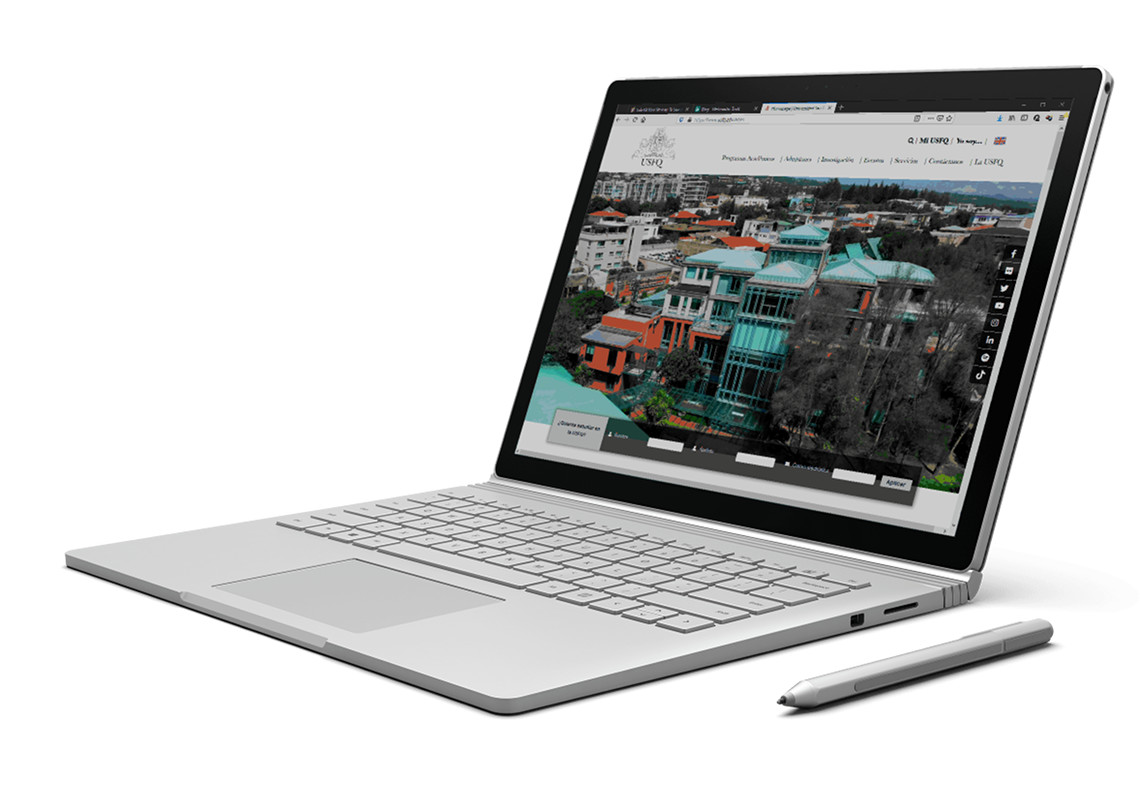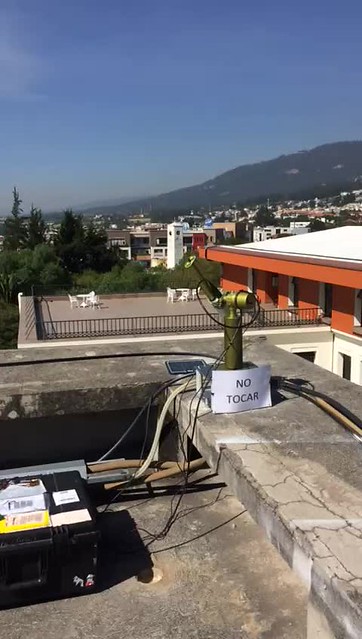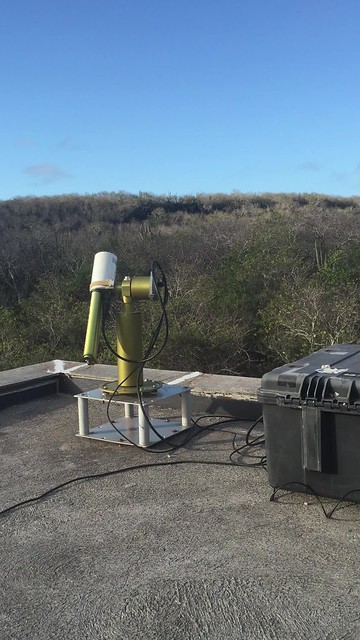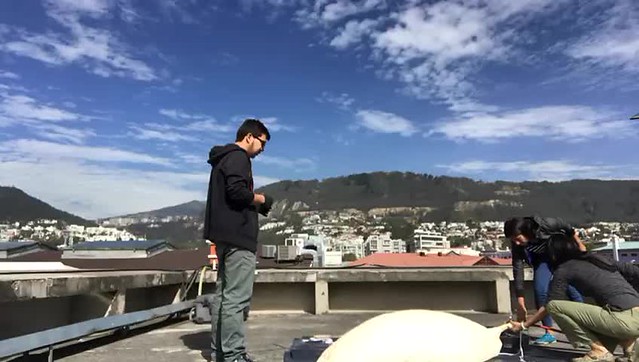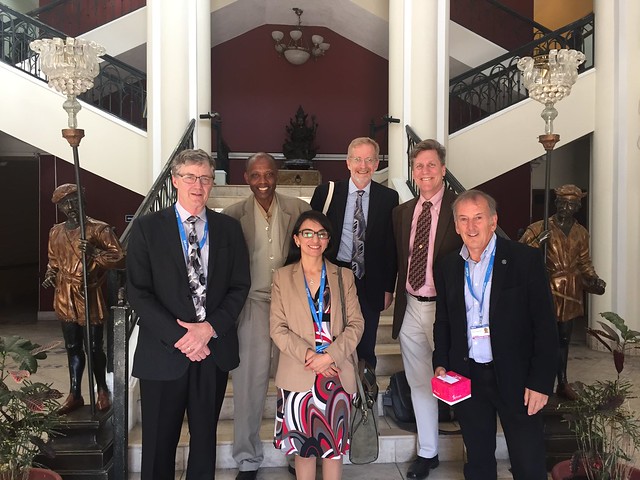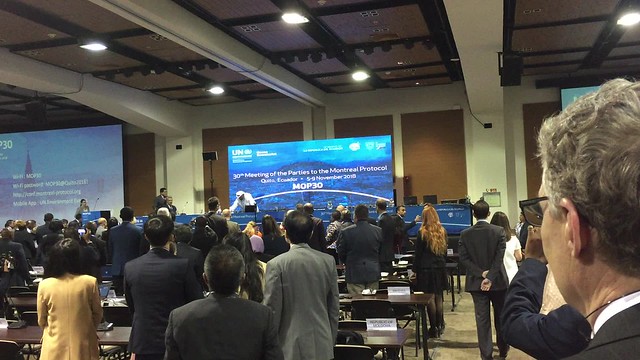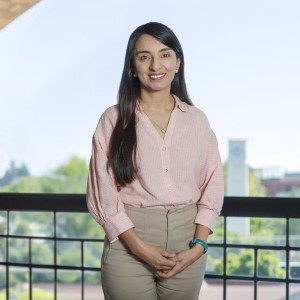Instituto de Investigaciones Atmosféricas (IIA)
The IIA USFQ is a scientific entity whose purpose is to investigate the phenomena of the local and regional atmosphere, integrating experimentation, computational modeling, and statistical data analysis. The experimental component of the IIA is carried out at the USFQ Atmospheric Measurement Station (EMA).
Physical sciences.
Physical meteorology, air quality, atmospheric measurements, instrument development, photochemical pollutant production mechanisms, radio and ozone atmospheric soundings, photometric measurements, emission inventories, transport, chemical, and dispersion models.
Researchers and students work at the IIA-USFQ to generate new knowledge that contributes to the understanding of meteorological phenomena and the mechanisms of origin, transport and destination of pollutants in the air.
The IIA-USFQ is an academic entity in which experimental and theoretical research is carried out, seeking to answer specific questions about the current state of science. IIA-USFQ projects will always have the active participation of students from science and engineering majors and prestigious international collaborators.
Faculty
Personal
Director
María del Carmen Cazorla, PhD
NASA Postdoctoral Fellow: Goddard Space Flight Center (2010-2012)
PhD in Meteorology: Penn State University (2005-2010)
Fulbright Scholar (2003-2005)
Office: BS 211 (Maxwell Building)
Tel .: 2971700 ext. 1128
EMA Atmospheric Measurement Station (M400)
Tel .: 2971700 ext. 1576
Technical staff
Edgar Herrera
Electronic Engineer: Universidad San Francisco de Quito
EMA Operations Engineer
USFQ Research Associates
Valeria Ochoa-Herrera, PhD
Dept. Environmental engineering
René Parra, PhD
Dept. Environmental engineering
José Ramón Mora, PhD
Dept. Chemical engineering
Luis Caiza, Ms
Dept. Electrical and Electronic Engineering
Ing. Nelson Herrera
Coord. Development and Maintenance
National and International Collaborating Researchers
William H. Brune
Penn State University
Brent Holben
NASA, Goddard Space Flight Center
Anne thompson
NASA, Goddard Space Flight Center
Bryan Johnson
NOAA (National Oceanic and Atmospheric Administration)
Patrick Cullis
NOAA (National Oceanic and Atmospheric Administration)
Current students
Daniela Chiquito
Environmental Engineering Project: Analysis of chemical composition in water samples. Year: 2020
Alumni
Wendy Vernaza
Environmental engineering
Thesis: Measurement of the rate of ozone production in the ambient air of Cumbayá using electrochemical cells and MOPS monitor. Year: 2019.
Nicolas Saud
Environmental engineering
Thesis: Calculation of the ozone production rate in Cumbayá (Ecuador) using VOC observations from previous studies. Year: 2018.
Rodrigo Pozo
Environmental engineering
Thesis: Exploratory study on the use of the F0AM model (The framework for 0-D atmospheric modeling) to calculate the rate of ozone production in ambient air in Cumbayá, Ecuador. Year: 2017.
Jocelyn Valencia
Environmental engineering
Thesis: Exploratory study on the detection of nitric acid (HNO3) and other nitrogenous species (NO2, NH4) [i.e. NO-2, NH + 4] by aqueous chemistry methods in the ambient air of Cumbayá, Ecuador. Year: 2016.
Carolina Placencia
Environmental engineering
Thesis: Exploratory study to determine the UV index using spectral measurements of daylight. Year: 2016.
Julieta Juncosa
Environmental engineering
Thesis: Evaluation of the WRF model (Weather Research and Forecasting) between the surface and 30 km above Quito case studies between April and September 2015. Year: 2016.
Edgar Herrera
Electronic Engineering
Thesis: Design and implementation of an ozone generator control system and data processing for the EMA-USFQ. Year: 2016.
Mijail Bolaños
Electronic Engineering
Thesis: Design and implementation of the signal acquisition and control system for a dual-channel Ozone (O3) sensor and a detector for experiments at the EMA-USFQ. Year: 2015.
Ruth Salvador
Environmental engineering
Thesis: Experiment of vertical sounding of the atmosphere in the Cumbayá Valley, Ecuador, protocol for launching meteorological probes and preliminary results. Year: 2015.
Santiago Vargas
Electronic Engineering
Thesis: Design and implementation of a SCADA system (Supervisory Control and Data Acquisition) for the USFQ-MOPS project (Measurement of Ozone Production Sensor). Year: 2015.
Esteban Tamayo
Environmental engineering
Thesis: Atmospheric measurement station at the Universidad San Francisco de Quito (EMA), installation of physical meteorology instrumentation for the earth station and evaluation of the first three months of data. Year 2014.
Research
Projects
- Measurements of the rate of ozone production in the troposphere with the MOPS USFQ instrument.
- Study of the Upper Atmosphere in Quito: measurements of the planetary boundary layer.
- Monitoring of the tropospheric and stratospheric ozone column (ozone layer) onboard high-altitude balloons.
- AERONET Quito and Galapagos.
- Particles and ozone in the air in Quito: elucidating the smog production regime.
- Observations of physical meteorology and air quality and their relationships.
- The ECHOZ (Ecuadorian Highlands Ozonesondes) project: monitoring of the ozone layer over the equatorial Andes.
ECHOZ project under the Vienna Convention
In 2016, the United Nations, through the Ozone Secretariat, invited Ecuador to submit a proposal for the improvement of ozone science under the auspices of the Trust Fund for the Vienna Convention. USFQ submitted the scientific proposal for authorship of (PI) M. Cazorla: The ECHOZ (Ecuadorian Highlands Ozonesondes) Project. ECHOZ focuses on continuing on-site monitoring of the ozone layer over the equatorial Andes on board high-altitude balloons from the EMA USFQ with a higher sampling frequency and under the guidelines of interest from systematic observations of the Vienna Convention. Ecuador's proposal was officially channeled by the Government of Ecuador, through the Ministry of Industries and Productivity (MIPRO). In September 2018, the Ozone Secretariat sent the notification that ECHOZ was approved for financing, as indicated in the official report and as listed on the Ozone Secretariat website:
http://conf.montreal-protocol.org/meeting/orm/10orm/report/English/10ORM-REPORT.pdf
http://178.18.81.158/activities?page=2&language=fr
As circumstances allowed, Quito was the venue for the Thirtieth Meeting of the Parties to the Montreal Protocol (MOP30), which was held on November 5-9, 2018. The venue was managed by the Government of Ecuador (MIPRO) . As P. I. of the ECHOZ project, M. Cazorla participated in the working meeting to prepare the Country Position, led by MIPRO authorities, along with distinguished delegates from different institutions. Likewise, M. Cazorla participated as an observer in MOP30 and organized the parallel event in Ecuador entitled “Ecuador's efforts to improve ozone and climate science: observations in the Galapagos, the Andes, and the Amazon” in which scientists from the USFQ and INAMHI participated. On November 6, the members of the Scientific Assessment Panel (SAP) of the Montreal Protocol visited the facilities of the USFQ and the EMA (link to photo gallery). Our distinguished visitors were:
Paul Newman - Chief Scientist for Earth Science NASA Goddard Space Flight Center
David Fahey - Director of ESRL Ch emical Sciences Division at NOAA
Bonflis Safari - Head of Physics Dept. at University of Rwanda
John Pyle - Senior Professor of Atmospheric Chemistry at University of Cambridge
Stephen Montzka - Scientist at NOAA (author of the famous Nature paper on the recent increase in CFC-11 in the atmosphere).
Echoz Project.
NASA-USFQ Agreement
On September 16, 2016, USFQ signed a scientific cooperation agreement with NASA (National Aeronautics and Space Administration of the United States), in order to integrate the AERONET (Aerosol Robotic Network) remote monitoring network. María del Carmen Cazorla is the Principal Investigator of the Ecuadorian counterpart. Within the framework of this agreement, Brent Holben, director of the global network AERONET, visited the EMA USFQ and the USFQ Galapagos Extension in August 2017.
At the moment we have two monitoring points:
EMA USFQ, Quito main campus, coordinates 0.19ºS, 78.43ºW and 2414 masl: https://aeronet.gsfc.nasa.gov/new_web/photo_db/Quito_USFQ.html
USFQ Galapagos Extension, coordinate 0.89ºS, 89.61ºW, 22 masl: https://aeronet.gsfc.nasa.gov/new_web/photo_db/San_Cristobal_USFQ.html
The measuring instruments are CIMEL solar photometers. The photometer is mounted on a robotic arm programmed to permanently track the path of the sun in the sky, from sunrise to sunset, and to perform azimuth scanning routines of the sky. The instrument measures solar irradiance in nine spectral bands. Real-time measurements are processed to produce observations of optical depth by light scattering caused by aerosols (AOD Aerosol Optical Depth). The instrument also measures the optical depth of absorption of water vapor. These measurements are finally translated into observations of the total column of aerosols and water vapor on the monitoring points. The instrument is fully automatic and acquires and transmits data in real time. AOD measurements can be found at:
Publications
Relevant publications IIA-USFQ:
Cazorla, M. The ECHOz (Ecuadorian Highlands Ozonesondes) project: a contribution to monitor the ozone layer within the framework of the Vienna Convention. 30th Meeting of the Parties to the Montreal Protocol. 2018. http://conf.montreal-protocol.org/meeting/mop/mop30/presentations
Cazorla, M. and Juncosa, J., Planetary boundary layer evolution over an equatorial Andean valley: A simplified model based on balloon-borne and surface measurements. Atmospheric Science Letters, DOI: 10.1002 / asl.829, 2018.
Cazorla, M., Ozone structure over the equatorial Andes from balloon-borne observations and zonal connection with two tropical sea level sites. Journal of Atmospheric Chemistry, 74, 377-398, 2016.
Cazorla, M., Air quality over a populated Andean region: Insights from measurements of ozone, NO, and boundary layer depths. Atmospheric Pollution Research, 7, 66-74, 2016. UNEP and CCAC 2016, Integrated Assessment of Short-Lived Climate Pollutants for Latin America and the Caribbean: Improving air quality while mitigating climate change. Summary for decision makers. United Nations Environmental Program, Nairobi Kenya, 2016.
Cazorla, M. and Juncosa, J., Transition between the dry and rainy season in Cumbayá (Ecuador): 2014 to 2015 comparison from observations at USFQ’s Atmospheric Measurement Station (EMA). Advances in Science and Engineering, 7, C1-C4, 2015.
Cazorla, M. and Tamayo, E., Atmospheric measurement station at San Francisco de Quito University (EMA): ground-based physical meteorology instrumentation and assessment of initial measurements. Advances in Science and Engineering, 6, C21-C30, 2014.
Rivadeneira, L., Juncosa, J., Naciph, K., Cazorla, M., San Francisco de Quito University Faculty CO2 emissions due to transportation during the Spring Semester 2014. Avances en Ciencias e Ingenierías, 6, C1-C3, 2014 .
Naciph, K., Rivadeneira, L. Juncosa, J., Cazorla, M., Calculation of CO2 emissions of the San Francisco de Quito University belonging to the student transport category of the Second Semester 2012-2013. Advances in Science and Engineering, 5, C1-C5, 2013.
Cazorla, M., Analysis of hourly data on solar radiation and ozone abundance of the Quito Metropolitan District from 2007 to 2012. Advances in Science and Engineering, 5, C67-C78, 2013.
Resources
The EMA USFQ Atmospheric Measurement Station (0.19º S, 78.43º W, 2414 masl) is the experimental arm of the IIA. The EMA is located on the terrace of the Maxwell building, on USFQ's main campus. The EMA USFQ Atmospheric Measurement Station began operations in 2014 as a space for research, atmospheric monitoring and constant learning. The EMA has equipment for real-time meteorological and air quality measurements. Variables and processes monitored include:
- Physical meteorology: wind speed and direction, atmospheric pressure, temperature, relative humidity, solar radiation and precipitation.
- Air quality: concentrations in the ambient air of ozone and NOx.
- Monthly monitoring of thermodynamic variables and tropospheric and stratospheric ozone (ozone layer): radio and ozone soundings on board high-altitude balloons. From 2019 this activity (ECHOZ project) will be carried out under the auspices of the Trust Fund for the Vienna Convention for Research and Systematic Observations (see link). This activity also allows in situ measurement of the depth and structure of the planetary boundary layer.
- Optical depth of aerosols and water vapor: NASA AERONET (see link).
- Daylight spectral measurements and UV index estimation.
- Measurements and model of the rate of ozone production in the troposphere: MOPS USFQ (Measurement of Ozone Production Sensor at USFQ) and FOAM model (Framework for 0-D Atmospheric Modeling).
Specialized measurements: AOD (Optical Aerosol Depth):
The EMA USFQ has two solar photometers, one is located on the Cumbayá campus and the other on the USFQ Galapagos. These instruments measure the optical depth of aerosols and water vapor. Research - NASA AERONET CONVENTION.
CIMEL-AERONET NASA solar photometer
CIMEL solar photometer - NASA AERONET, Cumbayá campus CIMEL solar photometer
- NASA AERONET, Galapagos campus
ECHOz (Ecuadorian Highlands Ozonesondes): monitoring of the ozone layer.
We periodically launch radio pairs and ozone probes aboard high-altitude balloons from the EMA USFQ. We have an earth station telemetry system made up of an antenna, a signal preamplifier, a receiver, and a computer. The radio probe measures the thermodynamic variables known in slang as P-T-U (pressure, temperature, humidity), and the ozone probe measures the partial pressure of ozone. The signals from the radio and ozone probes are transmitted in real-time to the earth station with high resolution, corresponding to approximately 1 data every 5 meters of ascent. The deep sounding ozone of the ozone layer usually reaches 30-32 km above sea level.
As a pre-launch step, ozone probes need to be conditioned ten to fifteen days before flight. For this purpose, a test unit is used in which ozone concentrations are simulated and the current response of the probes is measured.
Daylight spectral measurements:
Optics, mini spectrometer and software for daylight spectral measurements and UV index estimation.
Optics, mini spectrometer and software for daylight spectral measurements and UV index estimation.
Optics, mini spectrometer and software for daylight spectral measurements and UV index estimation.
Measurements and model of the ozone production rate:
At EMA we have the USFQ version of the MOPS instrument, Measurement of Ozone Production Sensor (Cazorla and Brune, 2010). With this instrument we investigate the ozone production regime in the ambient air of Cumbayá. Additionally, we perform atmospheric chemistry runs with different mechanisms using the FOAM model, Framework for 0-D atmospheric modeling, (Wolfe, 2016). For this purpose we have a computer equipment with high processing capacity.
Atmospheric chemistry simulations:
Computer equipment with processing, memory and storage capabilities to run:
F0AM: The Framework for 0-D Atmospheric Modeling
TUV Tropospheric Ultraviolet and Visible Radiation Model
Baseline measurements:
Physical Weather:
The EMA USFQ acquires data from meteorological variables in real-time, through sensors whose measurements are continuously displayed and recorded at the earth station. Data acquisition systems designed in the EMA are used with National Instruments devices and the LabVIEW program. The data logger and the Vaisala application are also used for data visualization and recording.
The equipment used are:
Pyranometer
Measuring the global solar radiation at Wm-2, the spectral response of the sensor is 300-3000 nm.
Sonic anemometer
Measure the three vector components of wind and sonic temperature.
Temperature and relative humidity sensor with radiation shield.
High precision barometric pressure sensor.
Tipping bucket-type rain gauge.
Vaisala Data Logger
It stores the data collected by the sensors, for which it presents a card with internal memory which makes the station autonomous.
Air quality:
The EMA USFQ monitors in real time the concentrations of ozone (O3) as well as nitrogen dioxide (NO2) and nitrogen monoxide (NO) which, collectively, are called NOx.
The ozone sensor is a Beer Thermo 49i law photometer.
The NO-NO2-NOx sensor is a Teledyne T200 chemiluminescence monitor.
At EMA USFQ we have a flow bench with our own hardware and software, which allows us to periodically calibrate the NOx analyzer. For this purpose, mixtures of different concentrations of NO are prepared from a certified standard of NO.
The data is acquired and stored in real time at the EMA with its own data acquisition systems and software applications.
EMA baseline data is available under Investigation - Daily Observations.
Gallery
CAMCA
Annual Congress of Meteorology and Air Quality(CAMCA)
CAMCA 2019
CAMCA 2018
CAMCA 2017
CAMCA 2016
CAMCA 2015
CAMCA 2014
Observaciones
